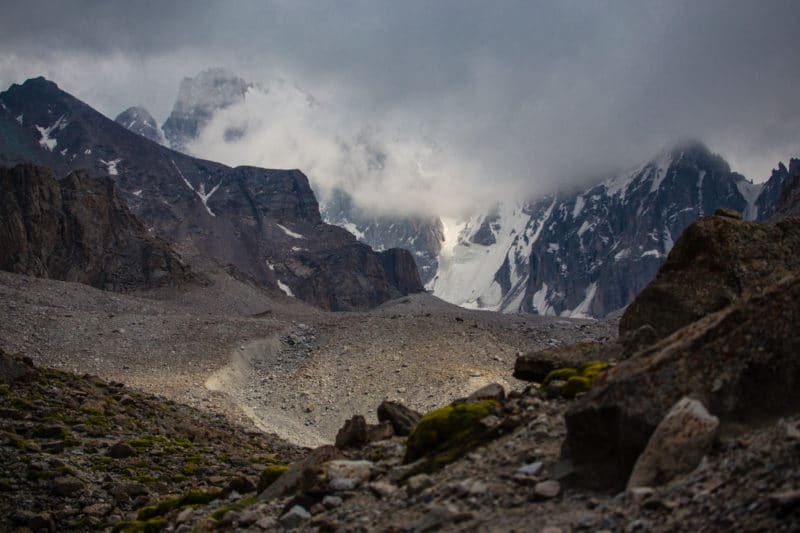Kyrgyzstan: Ratsek Hut
Кыргызстан: хижина рацека
A classic hike for climbers and trekkers in Kyrgyzstan, the trek to Ratsek Hut (хижина рацека in Russian) is for many local mountaineers the first step on holidays to climb the peaks that surround the Ak-Sai Glacier, for which the Ratsek Cabin is a popular base camp. Trekkers with no climbing experience can ascend the top of nearby Peak Uchitel, climb alongside the Ak-Sai or Uchitel Glaciers near the Hut, or simply enjoy the splendid views from the hut area itself.
Total Km: 16km
Total Days: 2+
Elevation Gain/Loss: 1850m+ / 1850m-
Start Point: Ala-Archa Alplager
End Point: Ala-Archa Alplager
GPS Files
The hike to the Ratsek Hut (known in Russian as хижина рацека and sometimes translated into English as Racek Camp – we’ll use these names interchangeably throughout) is physically demanding but not technically so, including the further climb along the side of the Uchitel Glacier to a viewpoint over a small glacial lake. Expect a long tiring day for the stage from Ala-Archa Base Camp up to the Ratsek Hut, a climb of over 1300 vertical meters over just six kilometers, so pack light and get an early start if you intend to do any additional side hikes on your day of arrival.
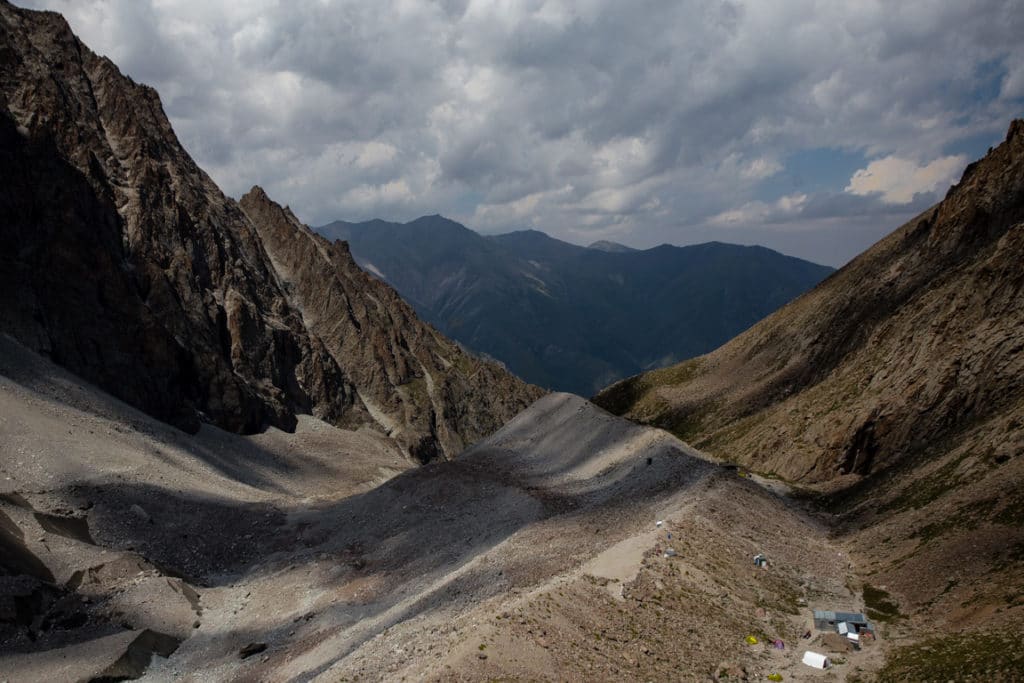
Ratsek Hut Stage 1:
Ala-Archa Alplager to Ratsek Hut (хижина рацека)
Total Km: 6km
Walking time: 4h
Total time: 5-7h
Elevation Gain/Loss: 1341m+ / 141m-
Starting from the Ala-Archa National Park’s Alplager hotel (also the trailhead for the Ala-Archa Valley Trail), the trail to Ratsek Hut cuts almost immediately to the left/southeast into forest cover and angles towards the hill that define the border of the forest – look for a sign that points to the Ak-Sai Waterfall, which is along the route to Racek Camp (хижина рацека).
Climbing slowly through the forest, a turn onto an open hillside also brings the first steep section of any note, though luckily it’s quite short. Topping out nearby a rock formation known as the ‘Broken Heart’ (for obvious reasons: the large cleft boulder appears vaguely heart-like in shape), the area is a popular rest or picnic spot for daytrippers from Bishkek who visit Ala-Archa to hike out to the waterfall or even only here as far as the Broken Heart. The views further up the Ala-Archa Valley are nice, and it’s from here that we see our first far-away glimpse of the Ak-Sai waterfall.
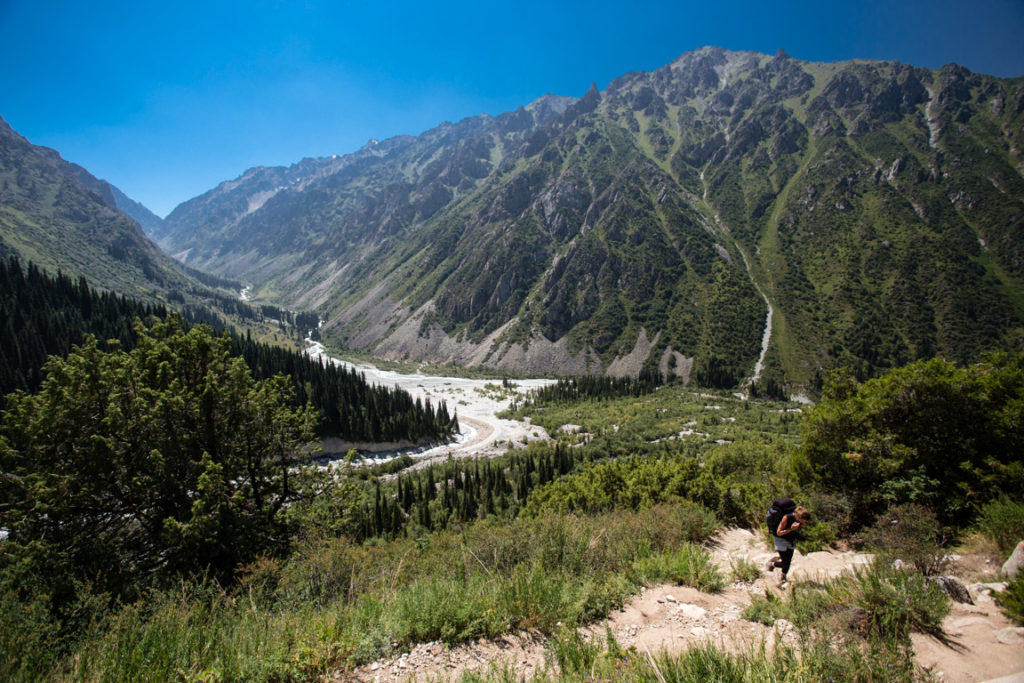
Ak-Sai Waterfall in Ala-Archa
From the Broken Heart, the trail continues gently climbing along the northern side of the Ak-Sai River Valley, dropping sharply to rock-hop across the Sharkyratma stream then climbing sharply back to the height of the pastureland above. Along the way, the Ak-Sai waterfall draws slowly into sharper focus as it comes nearer, a dark stain on the otherwise green hillside, made blacker by the angled sunlight that hides it in shadow through much of the day.
Cross a second stream just below the waterfall (the last reliable water source before the final climb to Ratsek Hut), and then arrive to a patch of beaten ground underneath a large stand of trees – a popular lunch spot for those who have come to the waterfall on dayhikes. Leave your pack here for the scramble up to the base of the waterfall about 45m of vertical just above; it gets quite busy on summer weekends, so the trail is well-beaten and easy to follow. Back at the bottom, fill up water bottles and re-shoulder backpacks for the bulk of the climbing to Racek Camp.
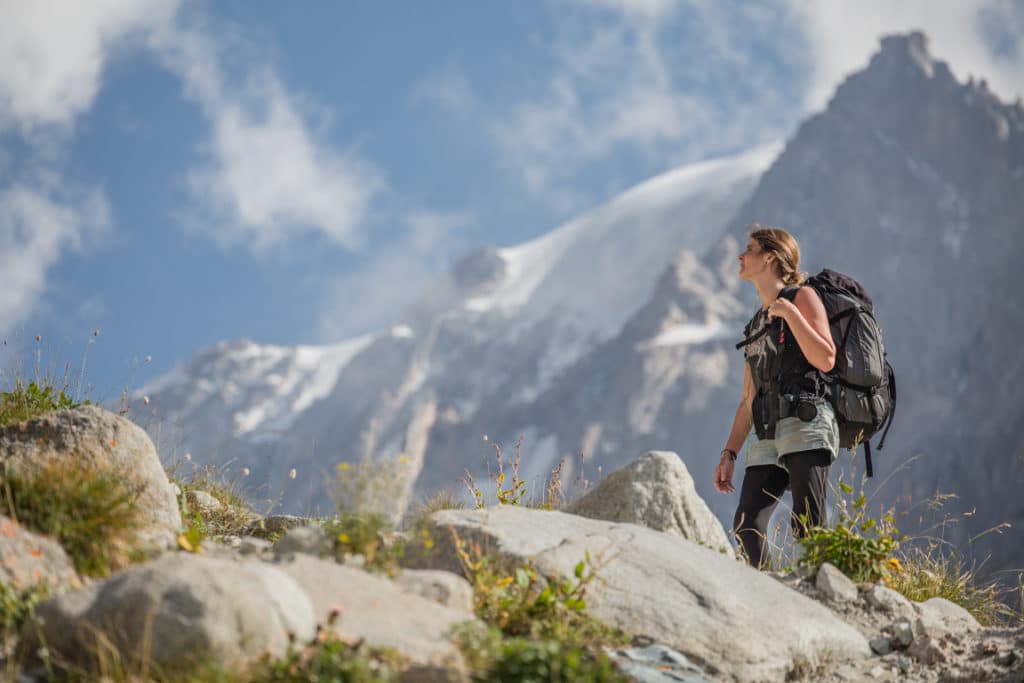
Beyond the waterfall, the trail begins to climb at a medium to sharp slope, first through a small copse of forest and then onto an open rocky hillside strewn with boulders cast off the glaciers ages before. Prepare for an unremitting climb – around 650m of vertical gain in two kilometers of lateral distance – but as the trail climbs alongside the old moraine it presents increasingly enormous views back down to the Ala Archa Valley and Alplager.
Though the trail is not always immediately obvious, the route more or less is – carry up and up along the exposed hillside, stopping occasionally to catch your breath or snap a photo, until there is simply no more climbing left to do.
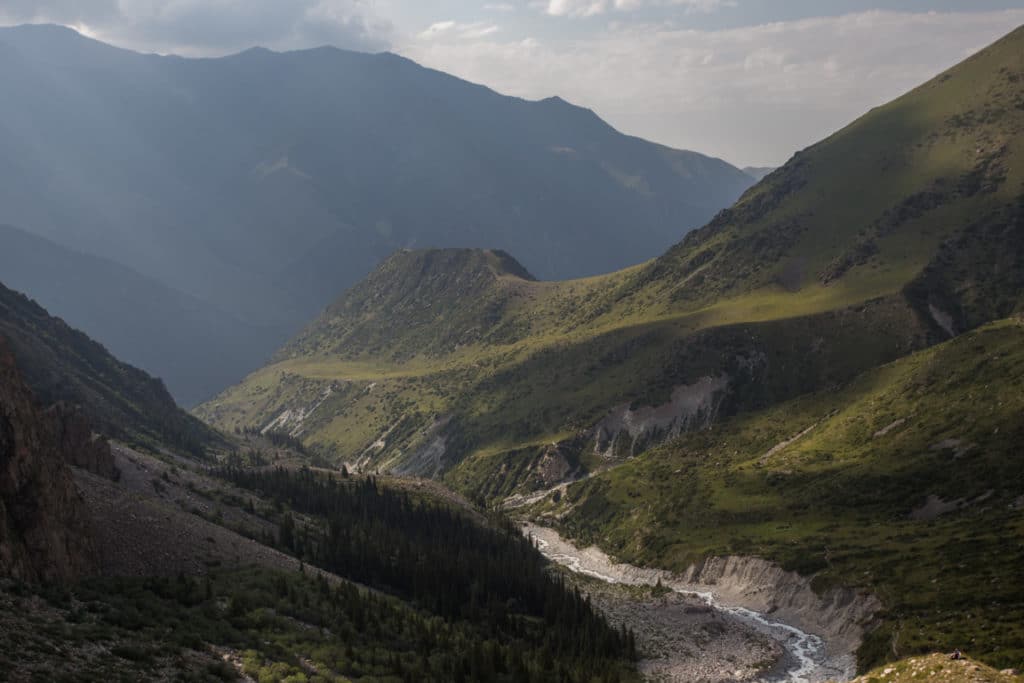
Racek Camp / Ratsek Hut
Finally, the trail levels out into a tiny swatch of pasture with a gurgling stream (which you’ll see later is fed mostly from a tiny waterall near the cabin). Follow this for around a quarter of a kilometer to a thin grassy area popularly used as a campsite – this is separate from the territory of the Ratsek Hut itself, and you don’t need to pay anything to pitch a tent here. The downside to camping here is that the toilet shack for this area is built atop the moraine wall that bounds the campsite to the south, so you’ll have a steep dark scramble for any midnight visits. The upside, of course, is that from the top of the moraine there are magnificent wide-open views of the Ak-Sai Glacier and surrounding peaks.
Another quarter kilometer on is the Ratsek Hut itself – a beautiful stone-built cabin that has been cleaned up considerably in recent years and leased to the Ak-Sai Travel tour company in Bishkek. Just before arriving to the cabin, at a small curve in the path of the glacial moraine, the full beautiful bulk of Peak Uchitel (4540m), Peak Baychecheky (4516m), Peak Semenova Tien-Shansky (4895m), and Peak Corona (4692m) come wonderfully into view.
The Ratsek Hut offers paid beds and camping spaces, as well as the possibility of pre-ordered meals; see the ‘Where to Sleep and Eat‘ section at the end of the article for details.
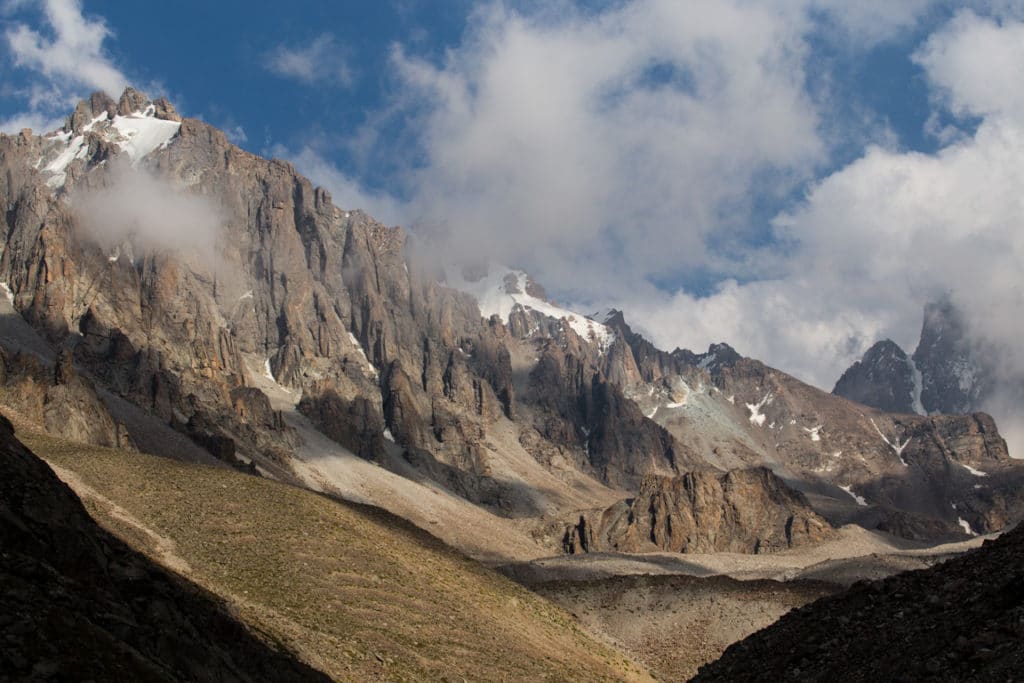
Ratsek Hut Stage 2:
Ratsek Hut to Uchitel Glacier Viewpoint (Round-Trip)
Total Km: 4km
Walking time: 3h
Total time: 4h
Elevation Gain/Loss: 368m+ / 368m-
From Ratsek Hut, look for the obvious hiking trail that leads southeast away from the cabin and climbs gently along the left-hand side of the valley. A little over half a kilometer up from the main Ratsek Hut is another smaller climbers’ cabin, from which a side trail climbs steeply up the rocky drainage to the northeast and eventually leads to the 4541m Peak Uchitel.
Continuing southeast, the viewpoint trail continues to climb in a somewhat sheltered position until it reaches the level of the Uchitel Glacier, after which is follows along the eastern edge over areas from which the glacier has receded. Though the path is not always clear, the route is well-marked with cairns and in any event there’s no need to stick too closely to one route – the only obstacle is the obvious rock outcrop visible ahead to the south. Keep an eye out for wildlife – along this stretch we were lucky enough to see a group of young ibex jumping among the rocks.
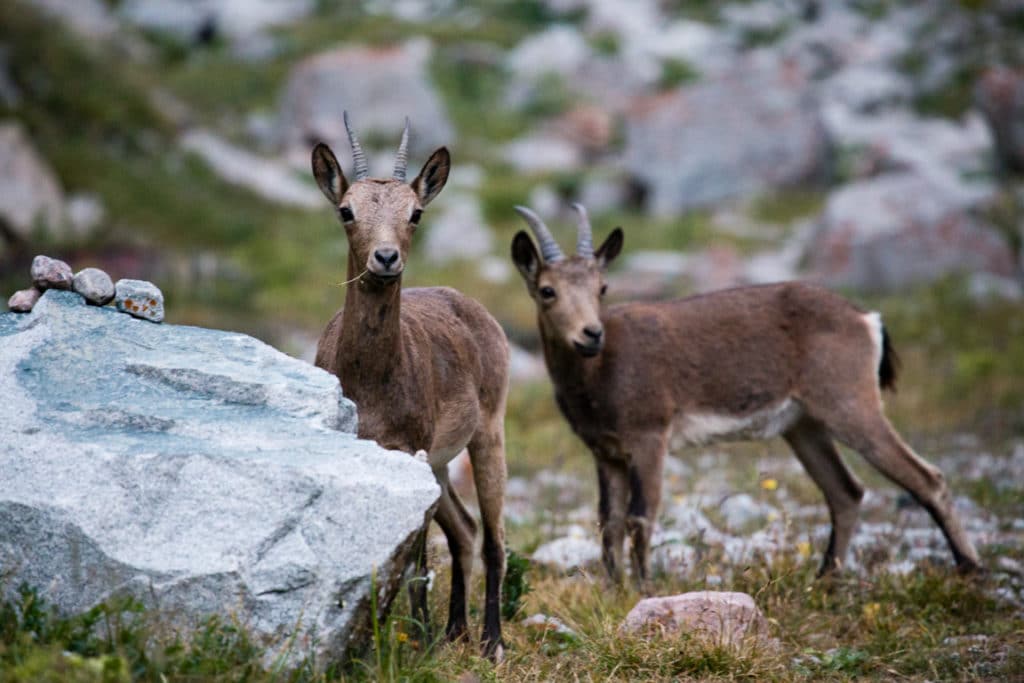
Above the looming outcrop is the Tomskiy Stoyanka – another much smaller climbers’ hut built as a forward camp for mountaineers making ascents of the peaks above, including the 4895m Peak Semenov Tian-Shanskiy (named after another iconic explorer and mountaineer who spent much time in modern Central Asia). Aim instead for the west side of the rocky outcrop, though, staying at a lower elevation until the small glacial lake comes into view – the lake itself isn’t much, but the surroundings are divine.
It’s very possible to continue onwards and upwards from here, for further and different views of the surrounding ridges, but beyond the lake the trail becomes a bit harder to follow and you’ll need to spend more time carefully picking your way amongst loose rocks. At any rate, when you’ve had an amazing picnic and enough walking for the day, return the way you’ve come back to the Ratsek Camp.
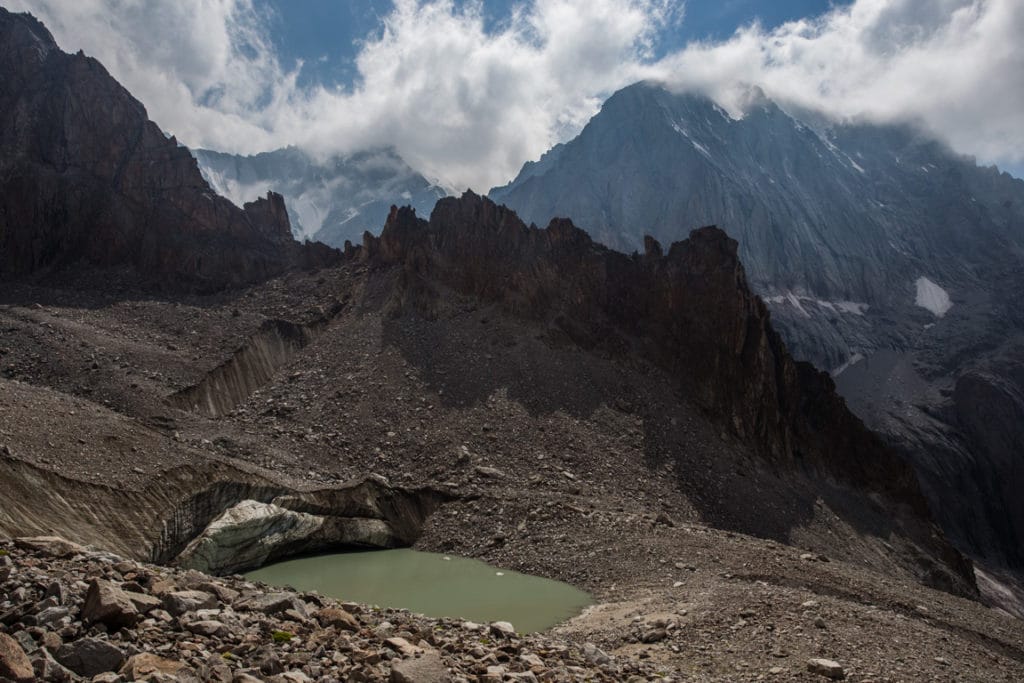
Ratsek Hut Stage 3:
Ratsek Hut to Ala-Archa Alplager
Total Km: 6km
Walking time: 3h
Total time: 3h
Elevation Gain/Loss: 141m+ / 1341m-
Return from Racek Camp (хижина рацека) to the Ala-Archa Alplager along the same route used for the ascent, down the gorge and past the waterfall then across the mostly-flat plateau and river crossing to the Broken Heart rock, before descending back to the alplager. All downhill on fresh legs, anticipate this taking far less time than the initial hike up; if you’re saved the lake viewpoint for your second day, it should still be no problem to hike to the viewpoint and back before lunch and then pack up camp and descend to the alplager in the same day.
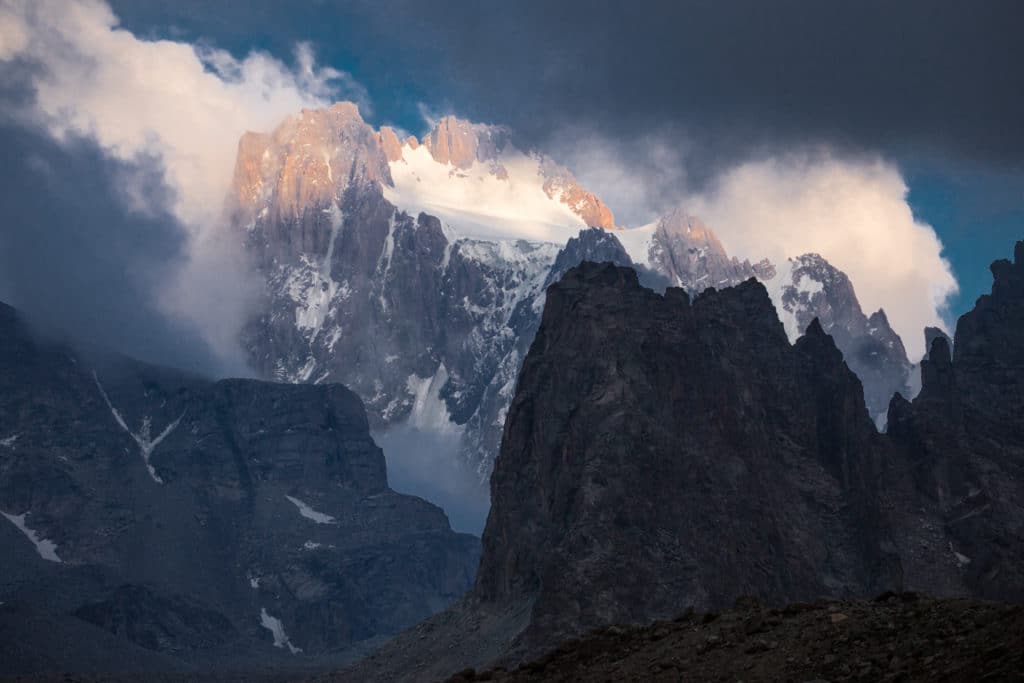
History of Ratsek Hut (хижина рацека)
Vladimir Ratsek, the namesake of the Ratsek Hut, was a Master of Sport in the USSR who made first ascents to numerous peaks throughout the Tien Shan including 7439m Peak Pobeda (now Jengish Chokusu, Kyrgyzstan’s highest peak). He served as a climbing trainer in the Soviet military and until 1969 as deputy commander for mountain training in the Turkestan Military District. He remains something of a legend among local mountaineers, and the Hut (хижина рацека) named in his honor is in fact one he was instrumental in the construction of during his time in the region – the 3972m peak immediately southeast of the camp shares his name as well. An interesting article about him is here on Wikipedia, in Russian only.
Alternate Options for Ratsek Hut Hike
Ratsek Hut is a common base camp for attempts on the many peaks that surround the Ak-Sai Glacier area. Most of these require climbing/mountaineering experience, with the exception of 4540m Peak Uchitel, which is a non-technical peak (though certainly still physically challenging). Topo maps of the area show additional routes leading over the ridge and down into Alamedin Valley, but we have not personally tested these and cannot comment.
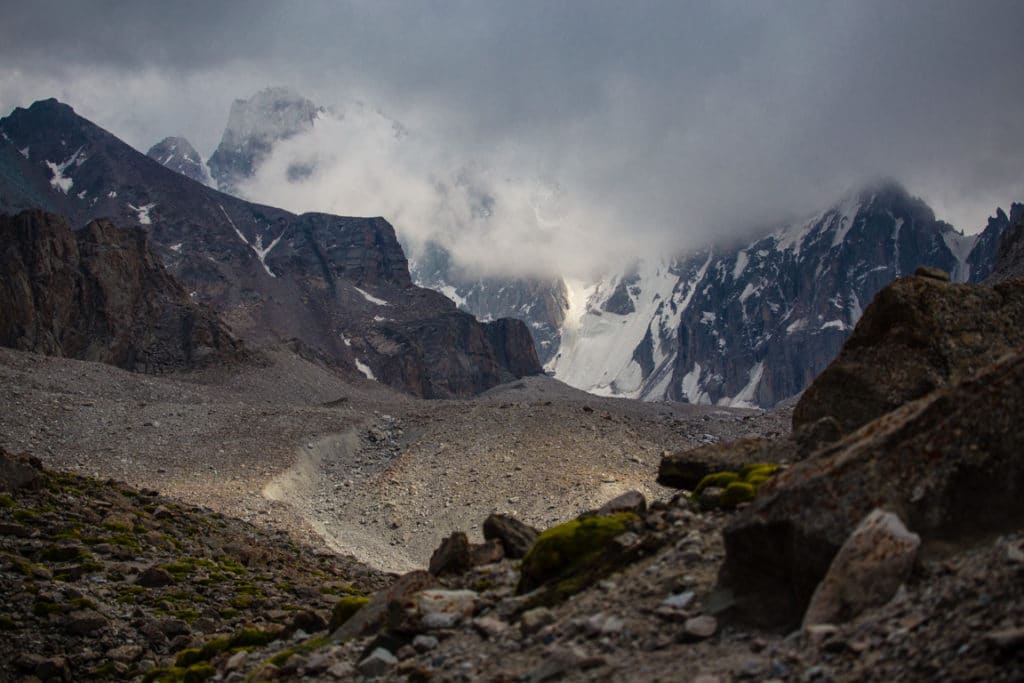
Good To Know
Entrance to Ala-Archa National Park is 80 KGS per person or 450 KGS per vehicle. There are no further fees to do the hike, though if you intend to sleep inside the Ratsek Hut or put your tent up on the territory immediately surrounding it you will need to pay a bit extra (see the ‘Where to Stay and Eat’ section below).
You’ll want a solid pair of trekking boots for this hike, especially if attempting it early in the season when river crossings may be high as a result of glacial melt. This hike is possible (and the Racek Camp [хижина рацека] typically open) in the winter as well, but will require a quality winter sleeping system as well as boots that can deal with hiking up the steep stretch of snowy climb between the waterfall and the cabin.
Getting to the Ratsek Hut Trailhead
From Bishkek’s Osh Bazaar, Marshrutka #265 departs irregularly from near the intersection of Toktogul and Beyshenaliev for 40 KGS, but it only goes as far as the village of Kashka-Suu (for an additional fee of 50KGS, some drivers will continue to the Ala-Archa Park Gate, but this is still 12km short of the trailhead at the Alplager).
Consider arranging a taxi or hiring a driver to take you all the way from Bishkek, but be sure to specify the Alplager trailhead and not just the park gate – you may pay anything from 500 KGS for a one-way transfer or 2400 KGS for a driver to take you both ways, but be sure to bargain and to clarify what all is included in the transfer price.
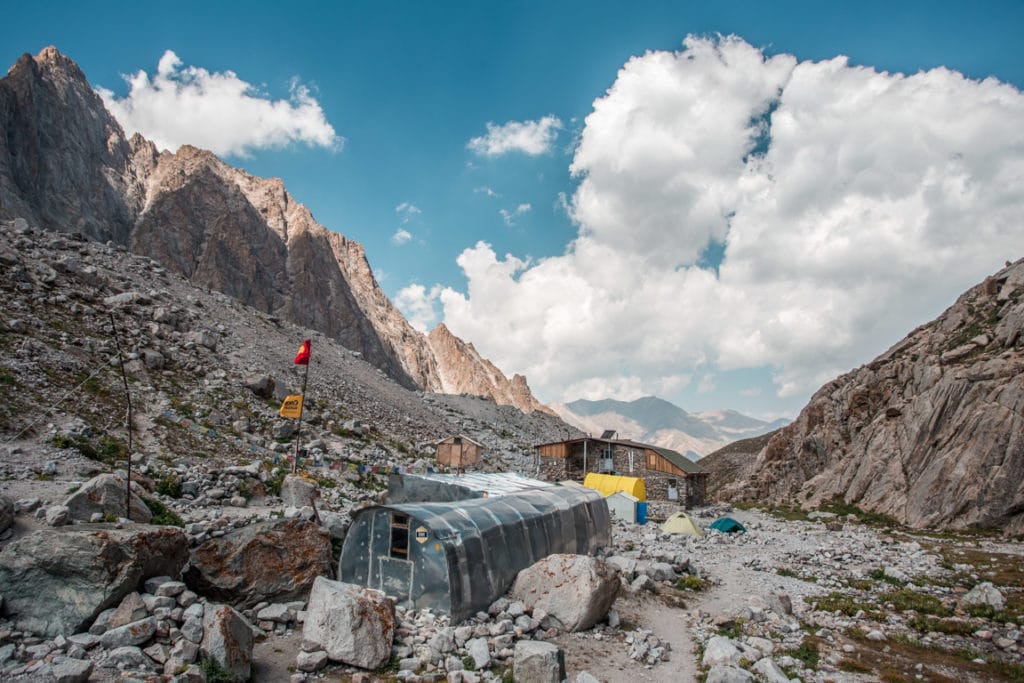
Where to Stay and Eat
It is possible to sleep in and source meals from the Ratsek Hut, though for food you need to arrange at least three days in advance by contacting Ak-Sai Travel at 0312-909-356 or adventure@ak-sai.com.
At the time of research in 2018, costs were as follows:
Dormitory space – 500 KGS per person per day
VIP Room – 5000 KGS per room per day *or* 1000 KGS per person per day
Rental Tent – 200 KGS per tent per day + 50 KGS per person per day
Tent Spot – 50 KGS per person per day
Beverages are generally available anytime: water (100 KGS), sodas (140 KGS), wine (1000 KGS), cognac (1000 KGS), vodka (700 KGS), beer (200 KGS).
Additionally, in the Ala-Archa alplager area, a small dormitory (500 KGS) and a more modern A-frame hotel are available for overnight accommodation.
We’ve also published a quick and dirty guidebook to show tourists around for their first few days in Bishkek. If you’re headed towards Kyrgyzstan and expect to need some help getting around, consider our Unanchor: Bishkek guide. Additionally, we contributed the Kyrgyzstan chapter to the most recent Lonely Planet: Central Asia guidebook. If you’re looking for more help than that, consider reaching out to our friends at Feel Nomad to organize a tour to the country.
